
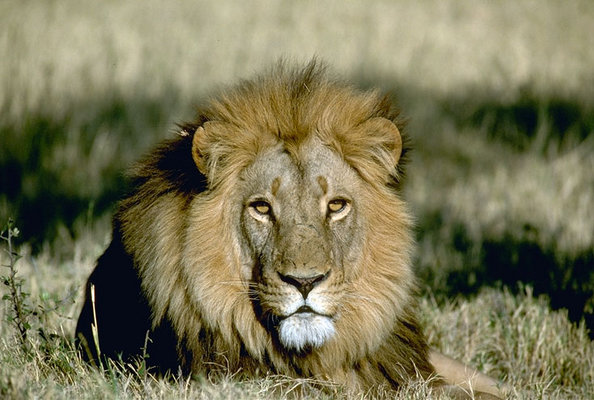
An African lion, Panthera leo, at the Okavango Delta, Botswana. © 2000 Greg and Marybeth Dimijian
Introduction
Found predominantly in Africa, lions are the largest felines in the world, and are often called the "King of the Beasts". Male lions are distinguishable from a considerable distance by their mane, which can be used as an indication of age, nutrition, and the climate of their habitat. Their large body mass provides an advantage in taking down prey, along with their powerful jaws and sharp claws.
Lions are social animals that hunt and live in groups called prides. The males have little parental investment toward the cubs, and males may even commit infanticide against suckling cubs that are not their own. There is usually fierce competition for food because successful hunts are rare and members of the pride tend to gorge themselves when food is available. The ruling male lion will eat his fill, and then the other males, females, and finally the cubs. The competition for food contributes to the high mortality rate of the cubs.
Classification
Lions belong to the genus Panthera which contains well known animals such as the tiger, leopard, and jaguar. Within the genus Panthera, the lion is further classifed as the species Panthera leo. The full scientific classification is as follows:
- Kingdom: Animalia
- Phylum: Chordata
- Class: Mammalia
- Order: Carnivora
- Family: Felidae
- Genus: Panthera
- Species: Panthera leo
The following chart shows the different species in the genus Panthera as well as the 16 subspecies of Panthera leo.
| Common Name | Species | Subspecies |
|---|---|---|
| (An extinct leopard) | Panthera crassidens | |
| European jaguar | Panthera gombaszoegensis | |
| Lion | Panthera leo |
|
| Jaguar | Panthera onca | |
| (An extinct cat) | Panthera palaeosinensis | |
| (An extinct leopard) | Panthera pardoides | |
| Leopard | Panthera pardus | |
| (An extinct cat) | Panthera schaubi | |
| (An extinct cat) | Panthera schreuderi | |
| Tiger | Panthera tigris | |
| Tuscany lion | Panthera toscana | |
| (An extinct cat) | Panthera youngi |
Habitat and Behaviour
Lions live in a wide range of habitats including plains, grasslands, forests, and even semi-deserts. They can also live at high altitudes, with a population spotted living at an altitude of 4,240 m in Ethiopia.
Groups of lions, called prides, can range anywhere between 2 to 40 lions with the average being 13 lions. They are composed of both sexes with the males having more dominance. Prides are needed as they benefit lions by increasing their hunting efficiency as well as defending their territories against other lions and animals. Lions greet each other by rubbing their heads together with their tails looped in the air as they moan.

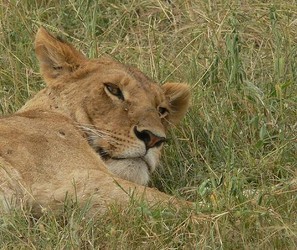
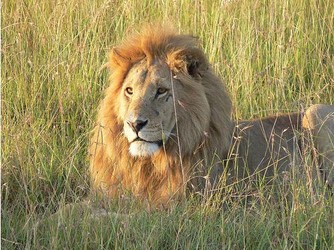
Female and male Panthera leo at Masai Mara, Kenya, © 2006 Richard Brooks
Morphology

A male lion roaring. © 2006 Richard Brooks
The length of a lion can range between 205-350 cm. They can weigh between 265-550 pounds and grow up to 109 cm tall. Both male and female lions have tawny-colored fur, but it can also vary in color from yellowish gray to dark brown. They possess powerful jaws as well as forelimbs that are stronger relative to their hind limbs.
Lions are sexually dimorphic, meaning there are morphological (physical) differences between the two sexes. Male lions develop manes as they begin to mature but females do not. The mane is an indicator of the lion's physical condition, such as nutrition, and it can be used to intimidate other lions as well as attract females. Research by B. D. Patterson suggests mane development in lions is affected by climate. It was found that lions living on higher elevated grounds possessed a more extensive mane compared to lions living in hot and dry places. The mass of the lion and the development of the mane also seem to have a direct correlation. Furthermore, lions held in captivity generally have a larger mane compared to wild lions, which is probably due to better nutrition as well as climatic effects.
Predation and Conservation
With lions being fierce carnivores, they have very few predators, which include humans, leopards, cheetahs and hyenas. Lions compete with the other big cats for food, and hyenas are known to kill lion cubs or weak adult lions.
Humans on the other hand are a big problem for lions as poaching has decreased the lion population over time. It is estimated that only 23,500 lions remain in African protected areas compared to 100,000 a quarter century before. Due to the decline in population, many African countries have protected areas to restrict lions from being poached.
Dietary Information and Hunting
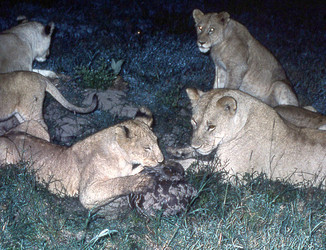
Lions at Serengeti National Park, Tanzania investigating a cape pangolin rolled into a defensive ball. © 2006
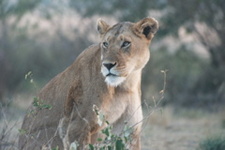
Female lion at Masai Mara, Tanzania. © Robert Moncrieff
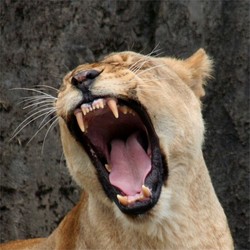
Female lion roaring, © 2006 Mila Zinkova
Lions hunt various animals and usually hunt in prides. Prides can have different food preferences from one another. Both sexes also have different preferred preys, with females hunting smaller prey such as zebras and males hunting larger prey such as buffalos. Their diet can be composed of zebras, buffalos, wildebeests, as well as small animals such as birds, fish, and rodents. Hunting efficiency of an individual lion is about 17% but around 30% in prides; this is probably one of the reasons why lions are usually in prides.
Lions usually hunt at night in groups comprised of females, since the manes of the males draw too much attention. While experts at stealth and ambushes, the lions are quite a bit slower than the prey they hunt to the extent that some prey do not even run away at their maximum speed. For this reason, lions use the darkness and bushes to conceal their presence, lying in wait near water holes and downwind from their prey to avoid being detected by scent. Although they can sprint up to 60km/h for short bursts, they are often unsuccessful because the prey they hunt is much faster.
Reproduction
Lions can reproduce all year round, but the female estrus period, when the female is in heat, peaks in the rainy season and lasts for four days. During the estrus period, the lioness will mate several hundred times in total. Usually, there is no fighting over females within a pride, as males will mate with many females. Takeover, or the attacking of one pride by another pride, occurs approximately every two years and is fought by the males. The winner will be able to mate with the females, ensuring that his genes will be passed on to the next generation.
Gestation period is three to four months, with the female giving birth to a litter of two to four cubs. After giving birth, the female will not mate for about two years. It is the female’s responsibility to raise the cubs and to wean them between seven and ten months of age. At about one year, the cubs start learning how to hunt, perfecting their technique by the time they are two years old. At this time, males are driven from the pride.
Miscellaneous Information
- The lion’s mane will darken over time to almost black in colour.
- Lions will only kill if they are hungry. If they are not out to kill, their prey will sense this and will often ignore them.
- Male lions do not have any parental responsibility.
- 80% of cubs will die before reaching two years old, when they become skilled hunters, due to the fierce competition for food.
- Males who become the ruling leader after a takeover will kill the suckling cubs, causing the females to go into estrus and mate with the new ruling leader of the pride.
- Ovulation is stimulated by mating.
- The mating of lions will end abruptly when the female shows aggression towards the male by displaying fangs and claws, causing the male to jump away before he is hurt.
- Lions can become infected by FIV (Feline Immunodeficiency Virus), much like the human HIV. In a South Africa park, 92% of lions tested were infected by it. Although it does not seem to affect lions greatly, FIV can kill domestic cats.
- Leo the lion is a mascot for a Hollywood film studio.

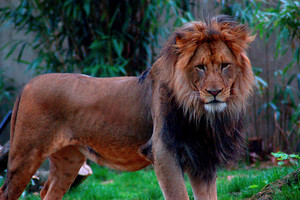




 Go to quick links
Go to quick search
Go to navigation for this section of the ToL site
Go to detailed links for the ToL site
Go to quick links
Go to quick search
Go to navigation for this section of the ToL site
Go to detailed links for the ToL site